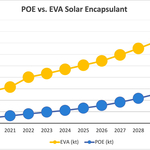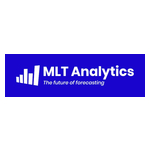- POE to partially displace EVA in solar modules
- Automotive PP compounds a growth, mainstay application
- POP prospects promising in monomaterial packaging structures
- New Asian entrants to transform supply situation
SINGAPORE–(BUSINESS WIRE)–#alternativeenergy—The global market for polyolefin elastomers and plastomers (POEs/POPs*) is forecast to grow at 7.4% per annum (CAGR) through to 2030 to a value approaching US$6.3 billion and volume of 3 million tonnes-plus according to a ground-breaking report released this month by MLT Analytics. This impressive growth is set to be fueled by strong gains in solar panel encapsulation at the expense of ethylene vinyl acetate (EVA) resin, supported by advances in impact modification of automotive polypropylene (PP) compounds, and sealant layers in flexible packaging.
�2021 was a breakout year for POE usage in solar module encapsulation,� says MLT Analytics CEO and co-founder Stephen Moore. �EVA supply constraints and resulting high prices, coupled with strong demand from the solar module sector in the second half of 2021 saw encapsulation sheet makers turn to POE to plug the supply gap. Now that POE has a stronger foothold, we expect it to make further gains accompanying increasing market penetration of bifacial solar modules, although POE is most likely to be used in conjunction with EVA rather than outright replacing it,� he adds.
Another key area to watch is sealant films for multilayer flexible packaging. �With the trend increasingly towards sustainable, monomaterial structures, lower sealing temperatures will become all the more important for converters and POPs can deliver on this performance requirement while realizing an airtight seal,� notes Moore.
Electric and autonomous vehicle adoption is also driving growth prospects for POE use as an impact modifier given the importance of lightweighting and the expectation that interiors of the future may utilize higher levels of PP. �Volume growth may be tempered by automaker and compounder efforts to minimize the use of costly POE impact modifiers in their formulations while still passing the mechanical property requirements,� cautions Moore.
Footwear and holt melt adhesives (HMAs) are other areas where POE suppliers plan to pursue market share, again at the expense of EVA. In these applications, competition is also anticipated from propylene-based elastomers. Used in blends with EVA, POEs can support higher foaming ratios for lighter weight sports shoe soles, as well as enhanced rebound resilience for faster lap times. POEs also bring several advantages over incumbent EVA solutions for adhesion, particularly in end-of-line paperboard and carton board packaging. �While POE-based HMAs are costlier than EVA on a per pound basis, the overall solution cost can be lower due to increased mileage and less line downtime, among other advantages,� says Moore.
On the supply side, incumbent POE/POP suppliers such as Dow Chemical, Mitsui Chemicals, ExxonMobil Chemical, SABIC SK Nexlene, LG Chem and Borealis may not have the market to themselves for much longer. While several niche suppliers have traditionally been active in Japan, new entrants are expected to emerge in China and elsewhere in Asia in the near to medium term and transform the supply situation.
Caption: POE and EVA will coexist as solar panel encapsulant materials, with the former enjoying stronger growth rates. Image: MLT Analytics
*For the purposes of this report POPs are defined as ethylene-based, metallocene-catalyzed plastomers of density 0.890�?0.915, while POEs are defined as ethylene-based, metallocene-catalyzed elastomers of density ?0.889.
For further information, please visit our website: www.mltanalytics.com
About MLT Analytics
MLT Analytics was established in June 2021 in Singapore by plastics industry market research veteran Stephen Moore and partners with the likeminded intent of applying machine learning (ML) technology and artificial intelligence (AI), augmented by extensive hands-on industry knowledge, to develop rational, robust and reliable forecasts. The company believes that solid domain expertise is essentially in the successful application of AI and ML. Hence, its team includes industry experts with decades of combined expertise in industries such as commodity, specialty and engineering plastics and elastomers, petrochemical feedstocks and products, specialty chemicals and additives. Expertise extends to processing, conversion and production equipment and plants, as well as downstream and end user industries such as automotive, hygiene, food and beverage, and packaging.
Contacts
Stephen Moore
[email protected]
www.mltanalytics.com








